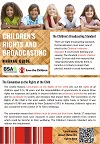Children’s rights and broadcasting
Also see our section on Classifications and timebands.
The Children's Broadcasting Standard
There are eight broadcasting standards that broadcasters must meet, one of which is the Children's Interests Standard. It covers both listening and viewing. The standard protects children (under 14 years old) from material that "disproportionately disturbs them, is harmful, or is likely to impair their physical, mental or social development".
The Convention on the Rights of the Child
The United Nations Convention on the Rights of the Child sets out the rights of all children, aged 0 to 18 years, and the responsibilities of governments to ensure those rights are respected and upheld. It ensures children are protected, provided for, and are able to participate in society and decisions that impact them. The Convention on the Rights of the Child is the most widely ratified human rights treaty in history! It was adopted in 1989 and ratified by New Zealand in 1993. In Aotearoa, children's rights are also considered in the context of Te Tiriti o Waitangi.
The convention means that children must be protected from harm. Article 17 states that the Government must have measures in place which protect children from content which could be harmful to their wellbeing. The Children's Interests Standard aims to address this requirement.
What To Do If Your Child Encounters Harmful Content
No tools will ever be completely failsafe or replace the personal guidance you can provide your tamariki. It’s worth taking the time to talk to young people about what they watch, how it makes them feel and what upsets them.
And if, despite your best efforts, they do see or hear something upsetting, talk to them.
How to talk to children exposed to upsetting content
- Make sure they know that you are grateful that they came to you.
- Reassure them it is not their fault.
- Provide comfort.
- Don't assign blame for coming across the material.
- Reassure them that their feelings and response is ok - that it is ok to
- be scared, worried or concerned.
- Don't take away or ban the technology, it is important they continue
- to feel they can talk to you.
- Together, come up with a safety plan to help avoid this happening in
- the future.
- Seek professional help if you or your child believes it is needed.
Making a complaint
If you believe a TV or radio programme breaches Children’s Interests or any broadcasting standard, you can make a formal complaint.
Generally, you must first complain directly to the broadcaster and they have 20 working days to reply. If they do not reply or you are unhappy with their response, you can complain to the BSA here.
Tools to Protect Children from Harmful Viewing
Parents and caregivers share responsibility with broadcasters for protecting children from viewing or listening harm.
Material likely to be considered under the Children's Interests Broadcasting Standard includes:
- Sexual material.
- Violent content.
- Offensive language.
- Dangerous, antisocial or illegal
- behaviour.
- Material where children or animals
- are humiliated or badly treated.
- Graphic descriptions of people in
- extreme pain or distress.
Ensure free-to-air TV and radio is accessed during children's normally accepted viewing or listening times, when greater protections apply.
- Up until 8.30pm
- Before and after school times
- Weekends and public holidays
- Excludes streamed services
Advisory labels - After the classification label, you’ll see advisories that tell you if the programme is likely to disturb kids or be outside audience expectations
- L = Language may offend
- S = Sexual content may offend
- V = Contains violence
- C = Content may offend
Classification Labels - Labels are shown in programme listings, at the start of most shows and after ad breaks.
- Look out for shows with a G classification – these are likely to be suitable for children.
- PG marks shows where parental guidance is recommended. These can be screened at any time.
- M, 16 and 18 classifications signal content that’s unsuitable for kids under 16 years old.
- News, current affairs, sports and live programmes don't have classifications, and may contain content unsuitable for children (regardless of screening time).
Parental locks can be used to block specific shows, channels or classification labels. This can be done on streaming services as well.
There are some great tools you can use to keep viewing and listening safe for you and your whānau. See this short video to get started.
DOWNLOAD GUIDE
